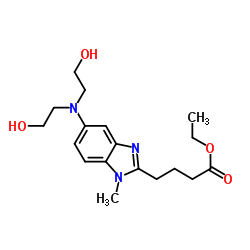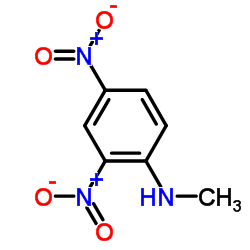CHEMICAL IDENTIFICATION
-
RTECS NUMBER :
-
DE1590000
-
CHEMICAL NAME :
-
2-Benzimidazolinebutryric acid, 1-methyl-5-bis(2-chloroethyl)amino-, hydrochloride
-
CAS REGISTRY NUMBER :
-
3543-75-7
-
LAST UPDATED :
-
199509
-
DATA ITEMS CITED :
-
8
-
MOLECULAR FORMULA :
-
C16-H21-Cl2-N3-O2.Cl-H
-
MOLECULAR WEIGHT :
-
394.76
-
WISWESSER LINE NOTATION :
-
T56 BN DNJ B1 C3VQ GN2G2G &GH
HEALTH HAZARD DATA
ACUTE TOXICITY DATA
-
TYPE OF TEST :
-
LD50 - Lethal dose, 50 percent kill
-
ROUTE OF EXPOSURE :
-
Oral
-
SPECIES OBSERVED :
-
Rodent - rat
-
DOSE/DURATION :
-
200 mg/kg
-
TOXIC EFFECTS :
-
Blood - changes in spleen
-
REFERENCE :
-
ATSUDG Archives of Toxicology, Supplement. (Springer-Verlag New York, Inc., Service Center, 44 Hartz Way, Secaucus, NJ 07094) No.1- 1978- Volume(issue)/page/year: 8,504,1985
-
TYPE OF TEST :
-
LD50 - Lethal dose, 50 percent kill
-
ROUTE OF EXPOSURE :
-
Intravenous
-
SPECIES OBSERVED :
-
Rodent - rat
-
DOSE/DURATION :
-
40 mg/kg
-
TOXIC EFFECTS :
-
Blood - changes in spleen
-
REFERENCE :
-
ATSUDG Archives of Toxicology, Supplement. (Springer-Verlag New York, Inc., Service Center, 44 Hartz Way, Secaucus, NJ 07094) No.1- 1978- Volume(issue)/page/year: 8,504,1985
-
TYPE OF TEST :
-
LD50 - Lethal dose, 50 percent kill
-
ROUTE OF EXPOSURE :
-
Oral
-
SPECIES OBSERVED :
-
Rodent - mouse
-
DOSE/DURATION :
-
250 mg/kg
-
TOXIC EFFECTS :
-
Details of toxic effects not reported other than lethal dose value
-
REFERENCE :
-
ARGEAR Archiv fuer Geschwulstforschung. (VEB Verlag Volk und Gesundheit Neue Gruenstr. 18, Berlin DDR-1020, Ger. Dem. Rep.) V.1- 1949- Volume(issue)/page/year: 43,16,1974
-
TYPE OF TEST :
-
LD50 - Lethal dose, 50 percent kill
-
ROUTE OF EXPOSURE :
-
Intraperitoneal
-
SPECIES OBSERVED :
-
Rodent - mouse
-
DOSE/DURATION :
-
71 mg/kg
-
TOXIC EFFECTS :
-
Details of toxic effects not reported other than lethal dose value
-
REFERENCE :
-
ABMGAJ Acta Biologica et Medica Germanica. (Berlin, Ger. Dem. Rep.) V.1-41, 1958-82. For publisher information, see BBIADT. Volume(issue)/page/year: 19,543,1967
-
TYPE OF TEST :
-
LD50 - Lethal dose, 50 percent kill
-
ROUTE OF EXPOSURE :
-
Intravenous
-
SPECIES OBSERVED :
-
Rodent - mouse
-
DOSE/DURATION :
-
80 mg/kg
-
TOXIC EFFECTS :
-
Blood - changes in spleen
-
REFERENCE :
-
ATSUDG Archives of Toxicology, Supplement. (Springer-Verlag New York, Inc., Service Center, 44 Hartz Way, Secaucus, NJ 07094) No.1- 1978- Volume(issue)/page/year: 8,504,1985 ** TUMORIGENIC DATA **
-
TYPE OF TEST :
-
TDLo - Lowest published toxic dose
-
ROUTE OF EXPOSURE :
-
Oral
-
SPECIES OBSERVED :
-
Rodent - mouse
-
DOSE/DURATION :
-
250 mg/kg/4D-I
-
TOXIC EFFECTS :
-
Tumorigenic - Carcinogenic by RTECS criteria Lungs, Thorax, or Respiration - tumors Skin and Appendages - tumors
-
REFERENCE :
-
ARGEAR Archiv fuer Geschwulstforschung. (VEB Verlag Volk und Gesundheit Neue Gruenstr. 18, Berlin DDR-1020, Ger. Dem. Rep.) V.1- 1949- Volume(issue)/page/year: 43,16,1974
-
TYPE OF TEST :
-
TDLo - Lowest published toxic dose
-
ROUTE OF EXPOSURE :
-
Intraperitoneal
-
SPECIES OBSERVED :
-
Rodent - mouse
-
DOSE/DURATION :
-
50 mg/kg/4D-I
-
TOXIC EFFECTS :
-
Tumorigenic - Carcinogenic by RTECS criteria Lungs, Thorax, or Respiration - tumors
-
REFERENCE :
-
ARGEAR Archiv fuer Geschwulstforschung. (VEB Verlag Volk und Gesundheit Neue Gruenstr. 18, Berlin DDR-1020, Ger. Dem. Rep.) V.1- 1949- Volume(issue)/page/year: 43,16,1974 ** REPRODUCTIVE DATA **
-
TYPE OF TEST :
-
TDLo - Lowest published toxic dose
-
ROUTE OF EXPOSURE :
-
Intraperitoneal
-
DOSE :
-
70 mg/kg
-
SEX/DURATION :
-
female 11 day(s) after conception
-
TOXIC EFFECTS :
-
Reproductive - Fertility - post-implantation mortality (e.g. dead and/or resorbed implants per total number of implants) Reproductive - Specific Developmental Abnormalities - musculoskeletal system Reproductive - Specific Developmental Abnormalities - other developmental abnormalities
-
REFERENCE :
-
ZPPLBF Zentralblatt fuer Pharmazie, Pharmakotherapie und Laboratoriums-diagnostik. (VEB Verlag Volk und Gesundheit, Neue Gruenstr. 18, 102 Berlin, Ger. Dem. Rep.) V.109- 1970- Volume(issue)/page/year: 110,1067,1971
|

 CAS#:3543-74-6
CAS#:3543-74-6![Methyl 4-{5-[bis(2-chloroethyl)amino]-1-methyl-1H-benzimidazol-2- yl}butanoate Structure](https://image.chemsrc.com/caspic/156/109882-25-9.png) CAS#:109882-25-9
CAS#:109882-25-9 CAS#:2044-88-4
CAS#:2044-88-4 CAS#:97-00-7
CAS#:97-00-7 CAS#:41939-61-1
CAS#:41939-61-1![isopropyl 4-(1-methyl-5-nitro-1H-benzo[d]imidazol-2-yl)butanoate Structure](https://image.chemsrc.com/caspic/395/1374784-01-6.png) CAS#:1374784-01-6
CAS#:1374784-01-6 CAS#:1221157-09-0
CAS#:1221157-09-0![4-[(2,4-dinitrophenyl)methylcarbamoyl]butyric acid methyl ester Structure](https://image.chemsrc.com/caspic/191/1221157-10-3.png) CAS#:1221157-10-3
CAS#:1221157-10-3![Methyl 4-{5-[bis(2-hydroxyethyl)amino]-1-methyl-1H-benzimidazol-2 -yl}butanoate structure](https://image.chemsrc.com/caspic/101/109882-31-7.png) CAS#:109882-31-7
CAS#:109882-31-7 CAS#:16506-27-7
CAS#:16506-27-7